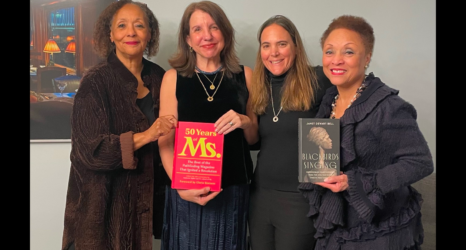In her new novel The Martyrs, the Lovers, Catherine Gammon carefully reinvents Petra Kelly’s life and mysterious death in a way deeply resonant for our current day and age.

The German activist Petra Kelly, perhaps best known as one of the founders of Germany’s Green Party, is both ghost and inspiration for Catherine Gammon’s fifth book, a novel.
However, you will not see anyone in these pages with the name Petra Kelly. Nor is there anyone by the name of Gert Bastian, her companion, and likely murderer in the double murder/suicide of the two.
The Martyrs, the Lovers tells the fascinating story of a modern-day Joan of Arc who stood up to the powers that be, and who dedicated her life to causes we are still fighting for; preserving the environment, standing up to fascism, resisting the war against women, emphasizing the hazards of nuclear power, and ultimately achieving peace.
Gammon’s protagonist is named Jutta Carroll, her lover is Lukas Grimm, and Gammon makes it clear that her use of Kelly’s life is meant to serve her storytelling. The fiction is exploratory in nature. It seduces the reader by way of exquisite language and pacing and a nonlinear approach, in addition to the depth and intensity of her research.
More than taking liberties, this novel should be seen as an entire reimagining of Kelly’s tragedy as it conjures her call to an activism that brought death threats upon her early on, and possibly had a hand in her and her lover’s actual deaths. Their bodies were found only after three weeks of moldering, “like medieval lovers.” Piecing together the life and times and important events of her main character, Gammon provides us with historical context even as she centers a young female resister who “knew,” from a young age, “who she was.”

Controversy surrounds the deaths of the lovers; we know this before reading. And so we enter into the fiction with both curiosity and fascination, which Gammon masterfully both milks and sustains as she gives us the details, enough to keep us guessing, like voyeurs, like amateur sleuths, as though we might deduce the truth from her fiction.
The novel begins and ends with the mystery of what was determined to be either a suicide pact or the murder and subsequent suicide of the surviving lover. Gammon conjures many potential scenarios for this cruel, unfathomable dual death. And she admits, “this, too, shall fail” to unravel the mysterious ending wherein a woman dedicated to a life of nonviolence could possibly agree to the double violence.
Throughout, Gammon provides Jutta with a remarkable capacity for empathy. We are taken deeply into her psyche, and it is both by way of the writing, along with the nobility—and controversy–of the very real Petra Kelly, that there is little we don’t want to know about Jutta. Gammon reels us in and gives us just what we need to understand what might compel Jutta in life.
Jutta, is driven to sacrifice for her dreams, has a healthy (if complicated) sexual drive, and finds herself drawn to older, married men. The most important among them is Lukas, a former officer in Hitler’s army (and later a general in the West German NATO-member army), whose remorse concerning his past may be partly responsible for his attraction to Jutta—not unlike the dynamic between Kelly and Bastian.
We get to know Lukas outside of the focalization by Jutta and our narrator. And of course Lukas, too, is fully reimagined. We are provided with a montage of his family, including his wife (he remains married) and the daughter who kills herself for her own inability to fathom her father’s participation in Hitler’s madness. (This character, fully invented, for example, doesn’t exist in the historic account.) At the same time, we are privy to Jutta’s family dynamics, especially her very close relationship with her grandmother and sister. We see the sensitivity of Jutta’s childhood: She suffered illness, and an abusive, abandoning father. She was a child who craved knowledge, a child who could not sleep the requisite 8-10 hours due to the delicate nature of her constitution.
Indeed, The Martyrs, the Lovers,—equal parts thriller, noir and murder mystery—enters into the consciousness of more than one character, but without letting the reader forget that this is Jutta’s story.
As a child, Jutta cannot come to terms with her father’s participation in the war, and leaves West Germany with her family for the United States. She grows up wanting to be a nun—and much later finds out that the very nuns she idolized were responsible for hiding Josef Mengele, the Nazi surgeon who experimented on Jewish bodies. Jutta studies the work of Gandhi, Rosa Luxemburg and Martin Luther King, Jr., works for Robert F. Kennedy and later Hubert Humphrey.
She returns to West Germany to help found the Green Party where she will uncompromisingly hold onto her ideals and prepare protest actions against Pershing missiles and nuclear power. Yet her marvelous story ends too soon. At the age of 44, Jutta dies at the hands of Lukas, her fellow martyr and lover—unless that isn’t how it happened at all.
Reading this book sent me to Petra Kelly’s story; I ransacked the Internet for information. But it is Gammon’s framing of the story that makes it even more haunting—the way she casts Jutta into the net of a very real history as well as the webs of the author’s own imagination. From this exhilarating exercise emerges a palimpsest, with Jutta’s story atop Petra Kelly’s, and a doubly powerful book. The Martyrs, the Lovers is deeply resonant for our day and age, as are the concerns of both the protagonist and the real politician and activist upon whom she is based.
Up next:
U.S. democracy is at a dangerous inflection point—from the demise of abortion rights, to a lack of pay equity and parental leave, to skyrocketing maternal mortality, and attacks on trans health. Left unchecked, these crises will lead to wider gaps in political participation and representation. For 50 years, Ms. has been forging feminist journalism—reporting, rebelling and truth-telling from the front-lines, championing the Equal Rights Amendment, and centering the stories of those most impacted. With all that’s at stake for equality, we are redoubling our commitment for the next 50 years. In turn, we need your help, Support Ms. today with a donation—any amount that is meaningful to you. For as little as $5 each month, you’ll receive the print magazine along with our e-newsletters, action alerts, and invitations to Ms. Studios events and podcasts. We are grateful for your loyalty and ferocity.





